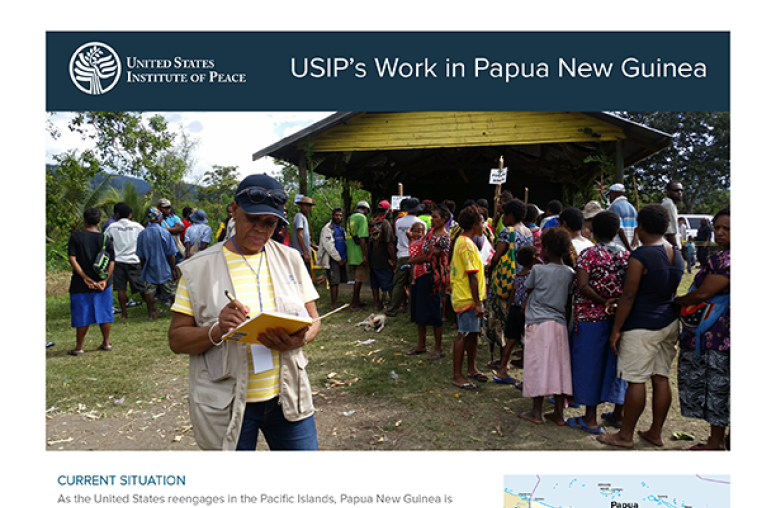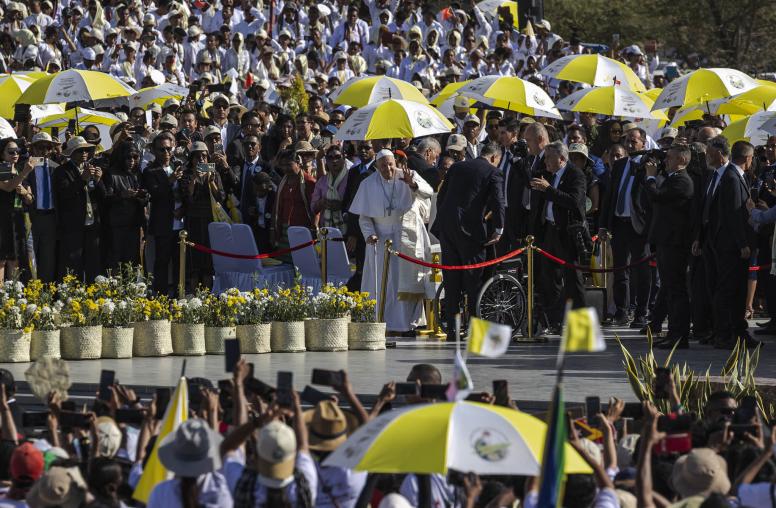What Does U.S. Reengagement in Papua New Guinea Mean for Bougainville?
As Beijing steps up engagement, Washington’s challenge in Bougainville, and elsewhere in the Pacific, is how to make up for decades of inattention.
This year marks the 80th anniversary of the U.S. Marine Corps landing at Cape Torokina in Bougainville following hard-won and pivotal battles in Solomon Islands. Despite the region’s strategic importance during World War II, in the post-war period the United States largely disengaged from the Pacific Islands not under its administration. Now Washington’s interest is increasing as the region once again becomes geopolitically contested.
![Bougainvilleans vote in Papua New Guinea’s 2017 general elections. In 2019, 97.7% of Bougainvilleans chose independence from Papua New Guinea in a nonbinding referendum. (Commonwealth Secretariat)]](/sites/default/files/styles/image_with_caption/public/2023-03/20230309-35439539542_97ecbdc652_o-flickr-commonwealth-secretariat-ac.jpg?itok=wTuP7Svl)
In September 2022, the United States announced the Pacific Partnership Strategy — the first-ever national strategy for the region — at the first-ever U.S.-Pacific Islands Summit. In February, the United States and Papua New Guinea made progress toward the signing of a defense cooperation agreement to strengthen military ties between the two countries.
As Washington reengages in the Pacific, it must not overlook Bougainville, an autonomous and want-away region of Papua New Guinea. The United States is neutral on Bougainville’s future political status, which is for Papua New Guinea and Bougainville to resolve. Nevertheless, Washington should recall long U.S.-Bougainville historical ties, and consider how the Pacific Partnership Strategy could be leveraged to benefit the people of Bougainville, whatever their future political status might be.
War Ghosts: Bougainville and the United States Share Unique Historical Ties
If you look closely enough, reminders of Bougainville’s past importance to the United States can be found across Washington D.C. and its surroundings. Just over the Potomac lies the Marine Corps Memorial commemorating the raising of the Stars and Stripes at Iwo Jima, one of the last major battles in the Pacific in World War II. At the memorial’s base are inscribed other major sites where the Marines fought. Between “New Georgia” (Solomon Islands) and “Tarawa” (Kiribati) is the name “Bougainville.”
One of the six men immortalized at the Marine Corps Memorial is Ira Hayes, a Pima Native American from Sacaton, Arizona, who fought on Bougainville and lies buried in Arlington Cemetery. During the Bougainville campaign, about 1,000 Americans, 500 Australians, and 12,000 Bougainvilleans — over a quarter of Bougainville’s pre-war population — lost their lives; Japan lost a staggering 40,000 men.
References to Bougainville can also be found at the Smithsonian’s National Museum of the American Indian. The Navajo code talkers on Bougainville helped the United States prevail, evading Imperial Japan’s spies by radioing encrypted information in their native language.
The U.S. role in the war lingered also in Bougainville’s historical imagination. In 1962, local leaders told a visiting United Nations delegation that administration of the islands — then Australian — should be assigned to the Americans, of whom there were still fond memories. Ultimately, Bougainville declared independence in 1975, shortly before Papua New Guinea’s own independence from Australia, but its motion was ignored by the international community.
While there are no U.S. memorials to the war in Bougainville, remnants of the conflict remain. To this day, the islands are marked by bits of tanks, cylinders, aeroplane propellers and even diving tanks repurposed as church bells. Armaments buried by American soldiers in 1945 became a munitions source for the civil conflict — known as “the crisis” — fought between Papua New Guinea and Bougainville and within Bougainville itself from 1988 to 1997. The conflict was largely fought over Bougainville’s natural resources and its aspirations for independence.
Bougainville and Papua New Guinea signed a peace agreement in 2001 and later established the Autonomous Bougainville Government. In 2019, an overwhelming 97.7% of Bougainvillean voters chose independence in a nonbinding referendum (partially funded by the United States). Papua New Guinea’s National Parliament has final decision-making authority over Bougainville’s future status.
Bougainville’s Foreign Relations Today
Despite the possibility of new nationhood, diplomatic engagement with Bougainville since the referendum has been sparing. There is one small Australian aid office in the region’s sleepy capital, Buka. Diplomats from embassies and missions accredited to Papua New Guinea’s capital, Port Moresby, fly in for a few days now and then. The United Nations provides largely administrative support to the consultation process between Bougainville and Papua New Guinea over Bougainville’s future status.
Presently, Bougainville does not represent a “pain point” for the international community. Talks are ongoing and chances of a return to violence so slender as to be practically non-existent. The Bougainville government itself is an almost soundless actor on the international stage, and the question of Bougainville’s future status struggles to gain even regional interest. For all these reasons, little concerted attention is paid.
But will this relative lassitude last as the Pacific Islands are increasingly caught up in geopolitical competition between China and the United States and its partners? Beijing has expanded its aid, trade and diplomatic footprint in the region substantially in the last decade. Bougainville, relatively isolated though it is from international attention, has not escaped China’s notice.
Beijing may have strategic, economic and diplomatic interests in Bougainville. In 2019, China reportedly expressed interest in building a port at Torokina and offered Bougainville $1 billion worth of infrastructure projects. While nothing of this scope has materialized yet, China’s clear strategic interest in neighboring Solomon Islands indicates that a strategic interest in Bougainville is not out of the question. Bougainville is also rich in natural resources, including the Panguna copper mine, which sparked the Bougainville crisis — it has been shuttered ever since — and is estimated to be worth 60 billion dollars. Finally, should Bougainville become independent, Beijing and Taiwan will likely vie for its diplomatic recognition.
Geopolitics aside, there is the major question of how Bougainville will fund itself, whatever its future status may be. The Bougainville government relies on grants from the government in Port Moresby and on foreign aid, generating only a few million dollars of its own revenue per annum. The government literally struggles to keep the lights on; power blackouts are an everyday occurrence. Meanwhile, it could take a decade to get the Panguna mine operational again. If Bougainville becomes independent, as it seeks to be by 2027, it will require a massive increase in foreign aid and new infrastructure to stand on its own feet.
The United States invested $10 million in aid between 2015 and 2017, making it the third largest investor in Bougainville, but far behind Australia and New Zealand. The United States has also helped support peacebuilding organizations and contributed stopgap funding to make up a $2 million shortfall in the budget of Bougainville’s Referendum Commission in 2019.
New Zealand provides a range of initiatives including police training and development support. Twenty-five years ago, it played a significant role in Bougainville’s peace process, making it a trusted partner. Its role in the present talks, however, is less front and center.
Australia is by far the largest aid donor to Bougainville, contributing $32 million a year. Australia’s aid investment focuses on important work such as transport, health funding, grants for cocoa cultivation and community development projects. Australia’s position — enunciated most recently at a ministerial forum with Papua New Guinea — is one of studied neutrality: “Bougainville's future political status was a matter for PNG and the Autonomous Bougainville Government to resolve.”
How Should the United States Engage with Bougainville Going Forward?
The United States’ main challenge in Bougainville, as elsewhere in the Pacific, is how to make up for decades of inattention. For instance, Washington played no role in the Bougainville peace process. However, the United States also has strengths in Bougainville, such as an air of neutrality that is vital when engaging with both the would-be breakaway region and Papua New Guinea. U.S. outreach to Bougainville should be managed carefully in order to preserve Washington’s important and growing relationship with Papua New Guinea. But Washington should continue to build on its modest but positive track record in Bougainville, especially now that it is reengaging in the Pacific more broadly.
The United States’ wide-ranging Pacific Partnership Strategy is designed to increase support and fulfill existing commitments to the Pacific Islands; support human rights and good governance; enhance economic opportunities, people-to-people ties and educational exchanges; and bolster climate change resilience, conservation, maritime security and health security. Bougainville, which shares many of the same challenges as its neighbors, would most likely welcome cooperation with the United States on the topics laid out in the strategy (as would elsewhere in Papua New Guinea).
Bougainville’s outlying islands are on the front lines of climate change, facing sea level rise and coastal erosion. Like the rest of Papua New Guinea, Bougainville’s health system needs support; so does its infrastructure. Enhancing educational opportunities and economic development could supplement existing efforts to address the needs of the “lost generation” impacted by the crisis. The United States recently announced new plans to tackle unexploded ordnance in Solomon Islands; Bougainville is likewise in need.
The United States could also expand on peacebuilding initiatives, such as helping establish peace memorials to the crisis and World War II, and lending support, if invited by both Bougainville and Papua New Guinea, to intergovernmental consultations and reconciliation efforts.
This year’s anniversary of the landings at Torokina presents an opportunity for the United States to engage in Bougainville more deeply. Last year, a high-level U.S. delegation visited Honiara, Solomon Islands, on the anniversary of the Guadalcanal campaign, and U.S. diplomats visited Kiribati to commemorate the Battle of Tarawa. Perhaps, later this year, visits to Buka and Torokina are in order.



